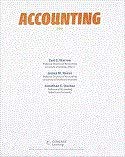
Concept explainers
(a)
Stock Dividends: It refers to the payment of the dividend to its shareholders by the corporation in the form of shares rather than cash is referred as stock dividend.
To
(a)
Explanation of Solution
Record the declaration and issuance of stock dividends.
| Transaction Number | Account Titles and Explanation | Debit ($) | Credit ($) |
| 1 | Stock Dividends (2) | 130,000 | |
|
Common Stock Dividends Distributable (3) | 40,000 | ||
|
Paid-in Capital in excess of Par Value-Common stock (4) | 90,000 | ||
| (To record the declaration of stock dividends) | |||
| 2 | Stock Dividends Distributable (3) | 40,000 | |
| Common Stock | 40,000 | ||
| (To record the distribution of stock dividends) | |||
Table (1)
Compute the number of stock dividends shares declared.
Compute the stock dividends amount payable to common stockholders.
Compute stock dividends distributable value.
Compute paid-in capital in excess of par value-common stock.
Transaction 1: Declared 2% of stock dividends.
- Stock Dividends is a contra-stockholders’ equity account which decreases the stockholders’ equity amount. Therefore, debit Stock Dividends account with $130,000.
- Common Stock Dividends Distributable is a stockholders’ equity account and the amount has increased due to the declaration of stock dividends. Therefore, credit Common Stock Dividends Distributable account with $40,000.
- Paid-in Capital in Excess of Par Value is a stockholders’ equity account and the amount has increased due to increase in capital excess of common stock value. Therefore, credit Paid-in Capital in Excess of Par Value account with $90,000.
Transaction 2: Distribution of stock dividends declared.
- Common Stock Dividends Distributable is a stockholders’ equity account and the amount has decreased due to transfer of Common Stock Dividends Distributable amount to Common Stock account. Therefore, debit Common Stock Dividends Distributable account with $40,000.
- Common Stock is stockholders’ equity account and the amount has increased. Therefore, credit Common Stock account with $40,000.
(b)
(1) Total paid-in capital, (2) total retained earnings, and (3) total stockholders’ equity amount before the declaration of the stock dividends.
(b)
Explanation of Solution
(1)
Determine total paid-in capital amount before the declaration of the stock dividends.
Hence, the total paid-in capital amount before the declaration of the stock dividends is $3,000,000.
(2)
Determine total retained earnings amount before the declaration of the stock dividends.
It is given that SL Company’s retained earnings before the declaration of the stock dividends is $33,500,000.
Hence, the total retained earnings amount before the declaration of the stock dividends is $33,500,000.
(3)
Determine total stockholders’ equity amount before the declaration of the stock dividends.
Hence, the total stockholders’ equityamount before the declaration of the stock dividends is $36,500,000.
(c)
(1) Total paid-in capital, (2) total retained earnings, and (3) total stockholders’ equity amount after the declaration of the stock dividends.
(c)
Explanation of Solution
(1)
Determine total paid-in capital amount after the declaration of the stock dividends.
Hence, the total paid-in capital amount after the declaration of the stock dividends is $3,130,000.
(2)
Determine total retained earnings amount after the declaration of the stock dividends.
Hence, the total retained earnings amount after the declaration of the stock dividends is $33,370,000.
(3)
Determine total stockholders’ equity amount after the declaration of the stock dividends.
Hence, the total stockholders’ equityamount after the declaration of the stock dividends is $36,500,000.
Want to see more full solutions like this?
Chapter 13 Solutions
Custom Bundle: Accounting, Loose-leaf Version, 26th + Working Papers, Chapters 1-17, 26th Edition
- High Tech Hardware began 2010 with a credit balance of $36,400 in the allowance for sales returns account. Sales and cash collections from customers during the year were $1,020,000 and $680,000, respectively. High Tech estimates that 8% of all sales will be returned. During 2010, customers returned merchandise for a credit of $29,000 to their accounts. High Tech's 2010 income statement would report net sales of $____?arrow_forwardI need help with this general accounting question using the proper accounting approach.arrow_forwardCan you solve this general accounting problem using accurate calculation methods?arrow_forward
- Savannah Manufacturing wishes to earn an after-tax net income of $35,000. Total fixed costs are $120,000, and the contribution margin per unit is $9.25. Savannah's tax rate is 30%. What is the number of units that must be sold to earn the targeted net income?arrow_forwardCosmic Corporation purchased a machine for $240,000 with an estimated useful life of 8 years and a salvage value of $40,000. Calculate the annual depreciation expense using the straight-line method and the book value of the machine after 5 years.arrow_forwardCan you provide the accurate answer to this financial accounting question using correct methods?arrow_forward
 Financial AccountingAccountingISBN:9781305088436Author:Carl Warren, Jim Reeve, Jonathan DuchacPublisher:Cengage Learning
Financial AccountingAccountingISBN:9781305088436Author:Carl Warren, Jim Reeve, Jonathan DuchacPublisher:Cengage Learning Financial And Managerial AccountingAccountingISBN:9781337902663Author:WARREN, Carl S.Publisher:Cengage Learning,
Financial And Managerial AccountingAccountingISBN:9781337902663Author:WARREN, Carl S.Publisher:Cengage Learning, Financial AccountingAccountingISBN:9781337272124Author:Carl Warren, James M. Reeve, Jonathan DuchacPublisher:Cengage Learning
Financial AccountingAccountingISBN:9781337272124Author:Carl Warren, James M. Reeve, Jonathan DuchacPublisher:Cengage Learning Managerial Accounting: The Cornerstone of Busines...AccountingISBN:9781337115773Author:Maryanne M. Mowen, Don R. Hansen, Dan L. HeitgerPublisher:Cengage LearningCentury 21 Accounting Multicolumn JournalAccountingISBN:9781337679503Author:GilbertsonPublisher:Cengage
Managerial Accounting: The Cornerstone of Busines...AccountingISBN:9781337115773Author:Maryanne M. Mowen, Don R. Hansen, Dan L. HeitgerPublisher:Cengage LearningCentury 21 Accounting Multicolumn JournalAccountingISBN:9781337679503Author:GilbertsonPublisher:Cengage





